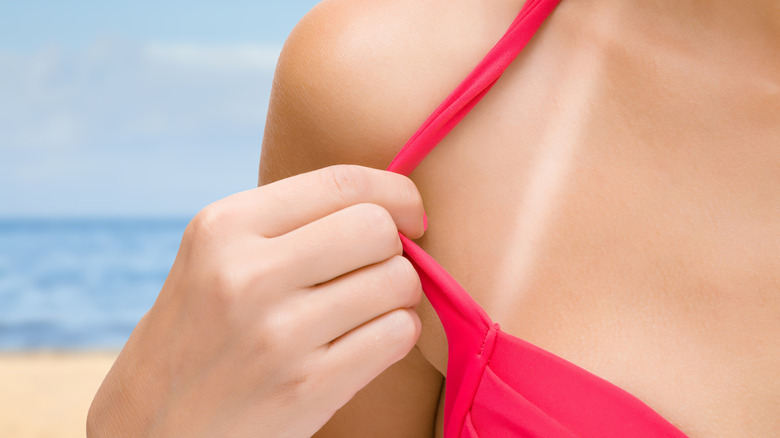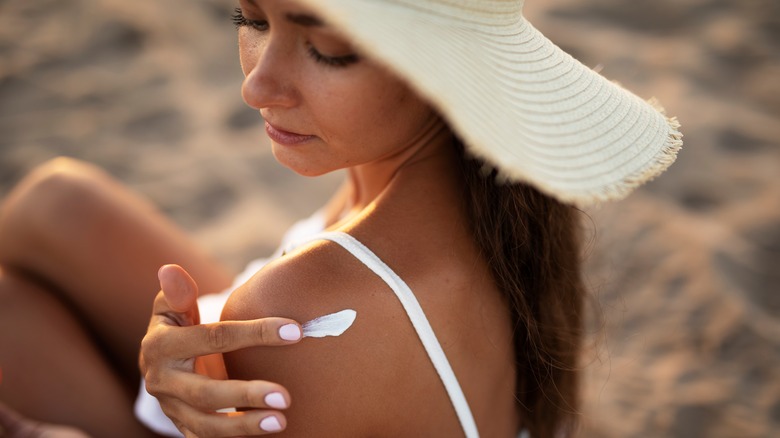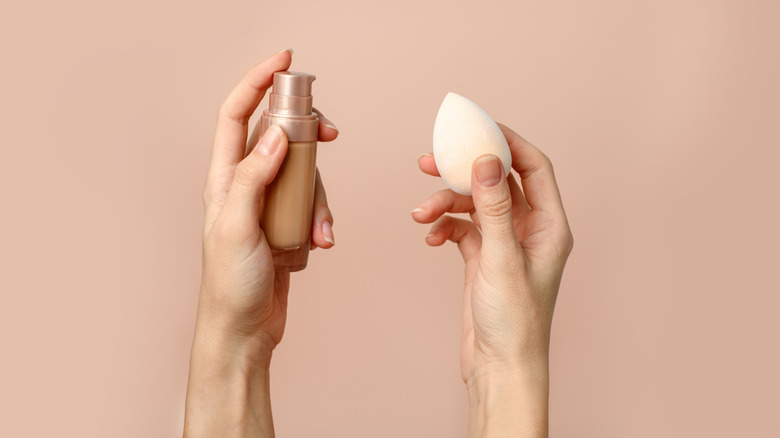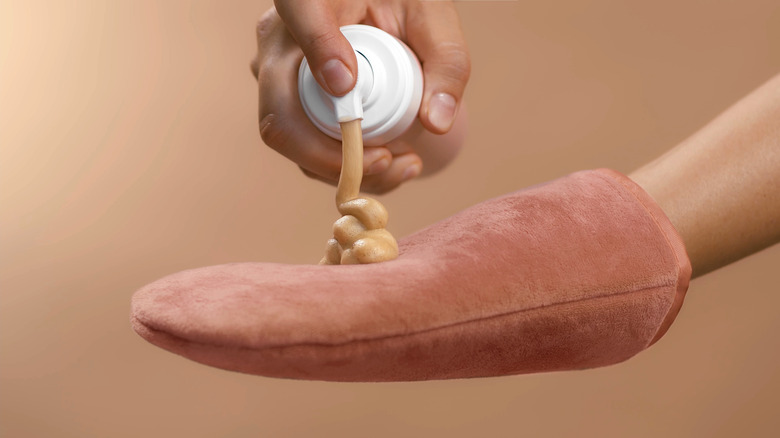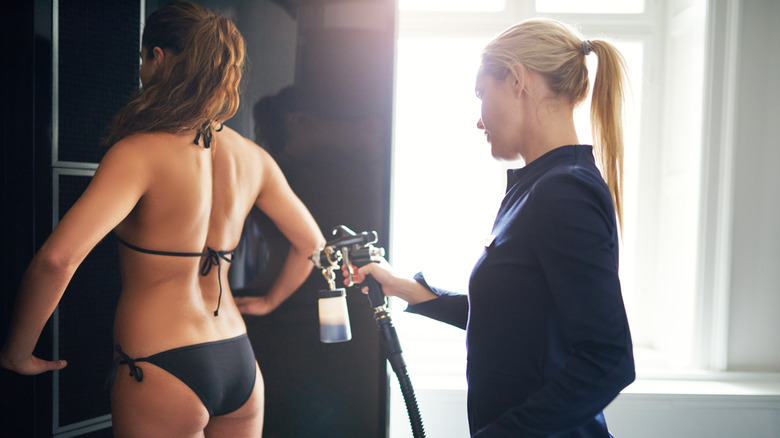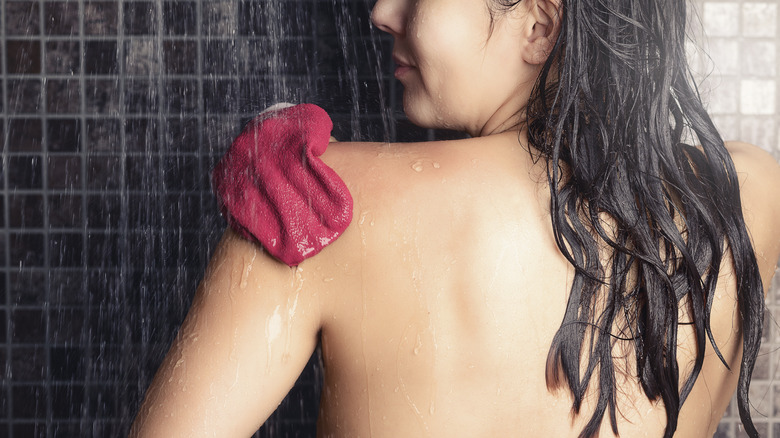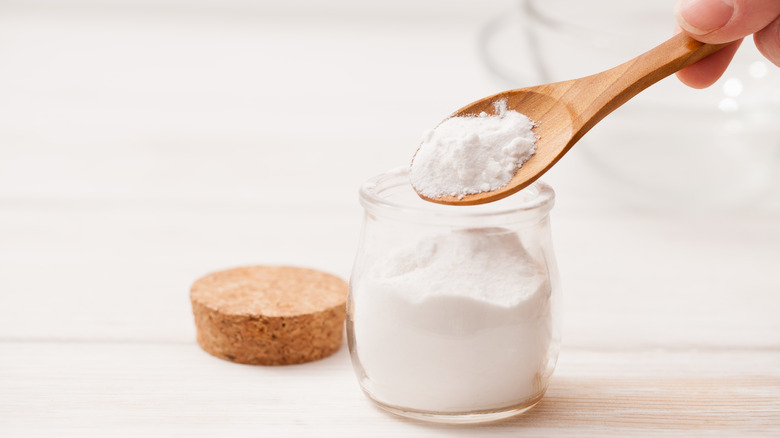Tips For Correcting Tan Lines Without Spending More Time Under The Sun's Rays
At this point, we hopefully all know that artificial tanning and exposure to UV rays is bad – like, really bad. I'm talking skin cancer, premature aging, and wrinkles bad. (Did I mention skin cancer?) With years of warnings from experts, and with so many resources at our fingertips proving just how bad it really is, at this point you likely know that tanning beds are bad for you and that you should wear sunscreen before going outside.
So while you're forgiven for watching too much Jersey Shore in the early 2000s and running to the tanning bed or laying out in the sun with tanning oil to even out tan lines, you're older and wiser now – and hopefully, you've learned to treat your skin with the respect it deserves. With that being said, tan lines can ruin a perfectly planned outfit and embarrassingly become the focal point of any photo. Luckily, you don't have to accept tan lines as your plus-one to your upcoming event, and these expert-approved tips can help you even out your tan lines in no time... without subjecting your complexion to further UV damage.
Prevention is easier than correction
It's important to note that the best way to avoid tan lines is to prevent them in the first place. Not only are tan lines difficult to get rid of, but they are also an indication of damaged skin, making it all the more important to avoid them in the first place. Protecting yourself from the sun's harmful ultraviolet rays can help protect you not only from unsightly and awkward-looking tan lines, but from sun damage that can lead to premature aging and skin cancer. "Wearing sunscreen with SPF of at least 30 is absolutely necessary to prevent any type of sun damage," says cosmetic dermatologist Michele Green, MD (per Cosmopolitan). Even after a tan line visibly fades, the damage left behind can be long-lasting, with Dr. Green noting that every time you tan, you are increasing your risk of wrinkles, sun spots, leathery-looking skin, and even melanoma.
So, as annoying as your tan lines may be when they take all the attention away from your new strapless dress, it's all the more important (and so much easier) to just avoid getting them in the first place. Preventing tan lines by applying sunscreen prior to spending time in the sun (and remembering to reapply) can save you the stress of having to worry about how to get rid of them.
Makeup
If you neglect to slather up on sunscreen before leaving the house or lose track of time and forget to reapply and end up with noticeable tan lines, there are ways to correct and conceal them. In general, makeup is the easiest, quickest, and most foolproof method.
Whether you are applying makeup to your face or to your body, celebrity makeup artist Jamie Dorman recommends exfoliating beforehand for an even, flawless application. "I recommend beginning by exfoliating the body part you're going to put makeup on, even the parts that won't need makeup, to create an even-textured surface and make blending easier," she says (via Huffpost).
When it comes to correcting tan lines on your face, makeup artist Gabriel De Santino recommends using a powder bronzer without any added shimmer or a peachy matte blush for the most natural finish (via The Zoe Report). He recommends using a makeup sponge to dab the product into the skin, blending out any harsh lines to ensure the finish looks natural.
Body makeup can be extremely useful when it comes to correcting tan lines on all other areas of your body. "To apply, first use a smaller concealer brush to fill in where the coverage is needed, and then use a damp sponge to buff the edges out," says celebrity makeup artist Mary Irwin (via The Zoe Report). Topping it off with a loose powder and a setting spray can help ensure the product doesn't transfer or smudge throughout the day.
Self-tanner
If you are confident in your application skills and are looking for something a bit longer lasting that doesn't need to be reapplied as often as makeup, self-tanner is a relatively easy way to even out the appearance of tan lines, and can be applied a day or two prior in preparation for a planned event that you don't want to be two-toned for. Tan lines fade, but vacation and wedding photos are forever.
"You can try using it all over to try to make the contrast less obvious, but a more effective method is to just apply fake tan to the light areas," says Michelle Wong (via Huffpost). She recommends exfoliating your skin prior to applying the self-tanner for an even application, and keeping the skin completely dry until the tanner dries to avoid any streaks.
St. Tropez's skin-finishing expert Sophie Evans recommends painting the lotion onto your tan lines using a kabuki makeup brush for large areas and a concealer brush for smaller areas. Since most self-tanners need to be left on for at least eight hours, she recommends sleeping with it on and then showering it off in the morning (via Byrdie).
Professional spray tan
While many people prefer to DIY using self-tanner in the interest of saving time and money, if you need to correct your tan lines in a pinch before a big event and are worried about messing up the application and looking like a streaky oompa loompa, it might be worth splurging on a professional spray tan. And while spray tans often get a bad rep for looking artificial or orange-tinted, when applied correctly and professionally, spray tans can leave you with a natural, sunkissed glow. They can also help even out the appearance of even the worst tan lines.
"Spray-on tans done by a professional are one option that can cover the entire body," says dermatologist Sheel Desai Solomon, MD (via Well + Good), making them a great solution for full-body tan lines. "Dihydroxyacetone (DHA) is a color additive that, when it comes in contact with dead skin cells on your skin's surface, temporarily darkens the skin. It's been approved by the FDA for this specific use." This makes it a safe alternative to a trip to the tanning bed while offering similar results. The higher the DHA, the darker the spray tan will be after drying. If you are worried about your spray tan looking natural, it's best to start out lighter and see how you like it. You can always make the decision to go darker if you want an even bronzier look or if your tan lines aren't fully concealed with a lighter application.
Exfoliate
While not a quick fix, exfoliating your skin can help speed up skin cell turnover and shorten the amount of time it takes for your tan to gradually fade. "You can scrub your skin and carefully exfoliate the parts where the tan lines are most visible," says Dr. Solomon (via Well + Good). "It'll also speed up the process of lightening tanned areas of your skin."
While exfoliation used to just mean body scrub and a washcloth (and some skincare gurus still swear by this method of mechanical exfoliation), chemical exfoliation is also extremely popular. The American Academy of Dermatology recommends it as the method for those who have sensitive or acne-prone skin, as harsh physical scrubbing can lead to irritation and worsened skin problems. While mechanical exfoliation works by physically removing the dead skin cells, chemical exfoliation works to gently dissolve them using ingredients like AHAs and BHAs to encourage cell turnover.
As desperate as you might be to even out your harsh tan lines before a big event, over-exfoliation can damage your skin even further and do more harm than good. Whether you use a scrub or a chemical exfoliator, make sure you always follow up with a healthy dose of moisturizer to prevent your skin from drying out.
Vitamin C
Studies show vitamin c helps lighten skin, making it an effective tool in helping to soften and fade harsh tan lines. Lemon juice is one of the most common, naturally-occurring sources of vitamin C, and also acts as a natural exfoliant, making it an effective tool in the fight against tan lines. Before you immediately run to your refrigerator and start juicing lemons, it's important to note that lemon juice is extremely acidic and should never be used alone or applied directly to your skin without diluting it first, as the acid is strong enough to irritate and even burn your skin. Stylecaster recommends mixing equal parts lemon juice and honey, with the honey making the lemon juice less potent while also acting as a natural moisturizer. Leave the mixture on for 25 minutes before rinsing.
In a pinch, celebrity facialist Joanna Vargas says you can even use potatoes, which are also rich in vitamin C. She recommends putting the potatoes into a blender to form a mask that can be easily applied to your skin, though she notes that you can also use slices of potato as well if you don't have a blender. Apply the mask to the dark edges of your tan lines and let it sit for 20 to 30 minutes and wipe it off (per Byrdie).
Baking soda
Baking soda is another household item that most people usually have on hand, making it a popular DIY ingredient in fading tan lines. "Baking soda is highly effective when it comes to toning down your tan," says Dr. Solomon (via Well + Good). "Put some baking soda in a glass of water and stir until you make a paste-like mixture. Apply the paste on the tanned areas of your skin and remove after 15 minutes. After a couple of days, your tan lines should be barely visible."
Additionally, baking soda can be doubly effective at evening out your tan when mixed with other ingredients. Dermatologist Dr. Anna Chacon recommends using it alongside lemon juice to create an acidic exfoliant by mixing them in a one-to-one ratio to create a paste. If you have sensitive skin and need an additive for the baking soda that is less harsh than lemon juice, you can also use baby oil. The mixture will create a paste that is gentler on the skin. Apply the baking soda mixture to your skin and let it sit for ten to 15 minutes before rinsing it off (per Insider).
